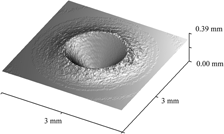Crossref Citations
This article has been cited by the following publications. This list is generated based on data provided by
Crossref.
Arizzi, Fabio
and
Rizzi, Egidio
2014.
Elastoplastic parameter identification by simulation of static and dynamic indentation tests.
Modelling and Simulation in Materials Science and Engineering,
Vol. 22,
Issue. 3,
p.
035017.
Brinckmann, Steffen
and
Quinkert, Lukas
2014.
Ductile tearing: applicability of a modular approach using cohesive zones and damage mechanics.
International Journal of Fracture,
Vol. 186,
Issue. 1-2,
p.
141.
Engels, P. S.
Begau, C.
Gupta, S.
Schmaling, B.
Ma, A.
and
Hartmaier, A.
2014.
Nanomechanical Analysis of High Performance Materials.
Vol. 203,
Issue. ,
p.
285.
Vajragupta, N.
Wechsuwanmanee, P.
Lian, J.
Sharaf, M.
Münstermann, S.
Ma, A.
Hartmaier, A.
and
Bleck, W.
2014.
The modeling scheme to evaluate the influence of microstructure features on microcrack formation of DP-steel: The artificial microstructure model and its application to predict the strain hardening behavior.
Computational Materials Science,
Vol. 94,
Issue. ,
p.
198.
Friedman, Lawrence H.
Vaudin, Mark D.
Stranick, Stephan J.
Stan, Gheorghe
Gerbig, Yvonne B.
Osborn, William
and
Cook, Robert F.
2016.
Assessing strain mapping by electron backscatter diffraction and confocal Raman microscopy using wedge-indented Si.
Ultramicroscopy,
Vol. 163,
Issue. ,
p.
75.
Wang, Mingzhi
Wu, Jianjun
Hui, Yu
Zhang, Zengkun
Zhan, Xuepeng
and
Guo, Ruichao
2017.
Identification of elastic-plastic properties of metal materials by using the residual imprint of spherical indentation.
Materials Science and Engineering: A,
Vol. 679,
Issue. ,
p.
143.
Wu, Jianjun
Wang, Mingzhi
Hui, Yu
Zhang, Zengkun
and
Fan, He
2018.
Identification of anisotropic plasticity properties of materials using spherical indentation imprint mapping.
Materials Science and Engineering: A,
Vol. 723,
Issue. ,
p.
269.
Engels, J.K.
Gao, S.
Amin, W.
Biswas, A.
Kostka, A.
Vajragupta, N.
and
Hartmaier, A.
2018.
Indentation size effects in spherical nanoindentation analyzed by experiment and non-local crystal plasticity.
Materialia,
Vol. 3,
Issue. ,
p.
21.
Engels, Jenni K.
Vajragupta, Napat
and
Hartmaier, Alexander
2019.
Parameterization of a Non-local Crystal Plasticity Model for Tempered Lath Martensite Using Nanoindentation and Inverse Method.
Frontiers in Materials,
Vol. 6,
Issue. ,
Brinckmann, Steffen
2019.
A framework for material calibration and deformation predictions applied to additive manufacturing of metals.
International Journal of Fracture,
Vol. 218,
Issue. 1-2,
p.
85.
HUI, Yu
WU, Jian-jun
WANG, Ming-zhi
ZHAN, Xue-peng
and
FAN, He
2019.
Equivalent strain hardening exponent of anisotropic materials based on spherical indentation response.
Transactions of Nonferrous Metals Society of China,
Vol. 29,
Issue. 1,
p.
77.
Biswas, A. K.
Das, Santanu
and
Das, Sanjoy
2020.
Square grid deformation in wedge indentation: a new mathematical approach.
SN Applied Sciences,
Vol. 2,
Issue. 7,
Liu, Wenqi
Lian, Junhe
Aravas, Nikolaos
and
Münstermann, Sebastian
2020.
A strategy for synthetic microstructure generation and crystal plasticity parameter calibration of fine-grain-structured dual-phase steel.
International Journal of Plasticity,
Vol. 126,
Issue. ,
p.
102614.
Wang, Mingzhi
and
Wang, Weidong
2021.
An Inverse Method for Measuring Elastoplastic Properties of Metallic Materials Using Bayesian Model and Residual Imprint from Spherical Indentation.
Materials,
Vol. 14,
Issue. 23,
p.
7105.
Hwang, Yewon
Marimuthu, Karuppasamy Pandian
Kim, Naksoo
Lee, Cheolsoo
and
Lee, Hyungyil
2021.
Extracting plastic properties from in-plane displacement data of spherical indentation imprint.
International Journal of Mechanical Sciences,
Vol. 197,
Issue. ,
p.
106291.
PRABHU, P.
KUMAR, M. SIVA
IQBAL, S. MOHAMED
BALAJI, A.
and
KARTHIKEYAN, B.
2022.
RESEARCH AND REVIEW OF CLAY AND GLASS FIBER REINFORCED POLYESTER NANOCOMPOSITE MATERIALS USING OPTIMIZATION TECHNIQUES.
Surface Review and Letters,
Vol. 29,
Issue. 01,
Nammalvar Raja Rajan, Aravindh
Krochmal, Marcel
Wegener, Thomas
Biswas, Abhishek
Hartmaier, Alexander
Niendorf, Thomas
and
Moeini, Ghazal
2022.
Micromechanical Modeling of AlSi10Mg Processed by Laser-Based Additive Manufacturing: From as-Built to Heat-Treated Microstructures.
Materials,
Vol. 15,
Issue. 16,
p.
5562.
Zavdoveev, A.
Zok, P.
Pozniakov, V.
Rogante, M.
Baudin, T.
Heaton, M.
Gaivoronskiy, A.
Zhdanov, S.
Acquier, P.
Solomijchuk, T.
Kostin, V.
Skoryk, M.
Klochkov, I.
and
Motrunich, S.
2023.
Effect of Pulse Current GMAW on the Yield Stress of the S460M TMCP Steel Welded Joints.
Metals and Materials International,
Vol. 29,
Issue. 3,
p.
795.





